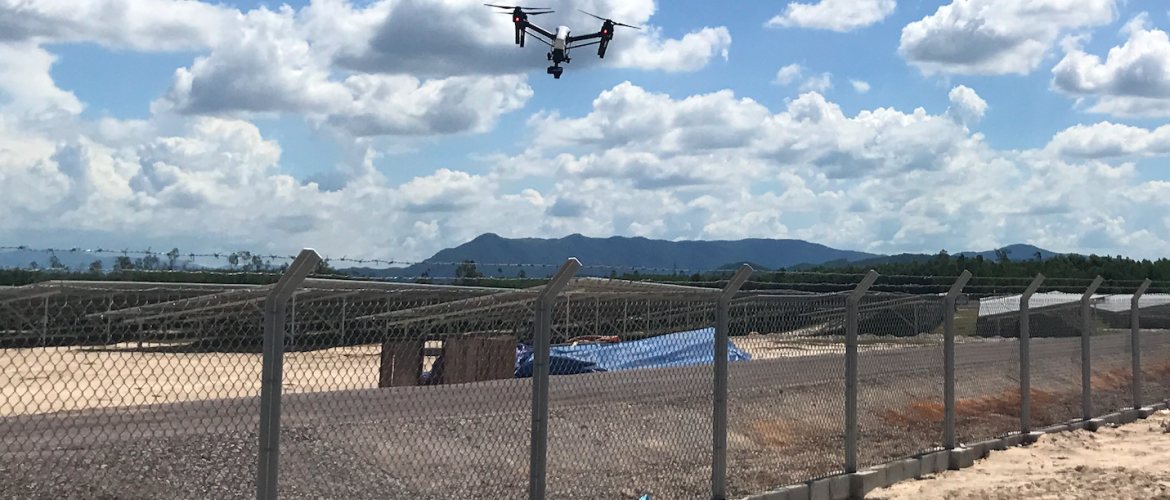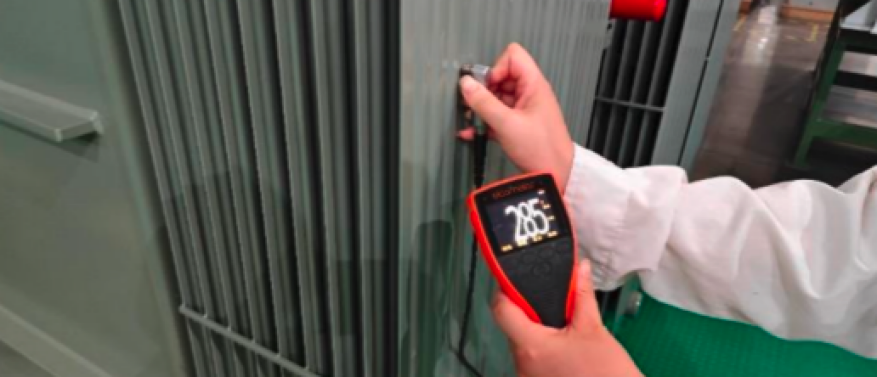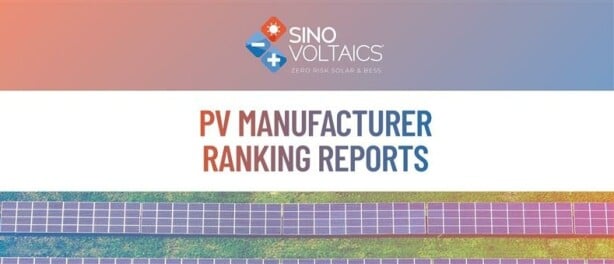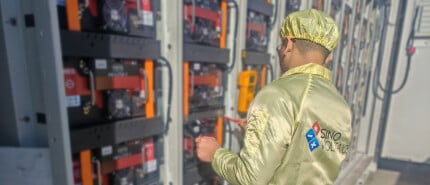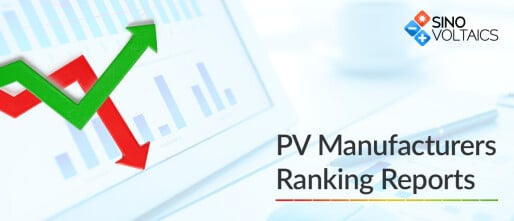In the execution of ZERO RISK SOLAR projects, we at Sinovoltaics take a wide approach to PV project risk management which not only involves the technical de-risking of the solar PV assets and investments, but also the elimination of risks associated with vandalism and theft.
Theft has for long only been a marginally discussed topic in the solar PV industry, but with more and more projects being deployed worldwide and an increase in project sizes, so do also increase the cases of solar power plants falling victim to burglary.
In this article, we look at the variety of available systems to protect a solar PV installation from theft, how they work and their major advantages and disadvantages.
Background
Theft of modules, inverters, cables and other valuable equipments from a solar PV installation is still a relatively underreported phenomenon, to the extent that comprehensive solar PV equipment theft statistics are scarce and the available reports and numbers only scratch on the surface of a supposedly much larger and underreported issue.
Random searches for news reports and articles about theft of solar equipment yield staggering figures on a global scale, spanning over several years up to as recent as the past few months in 2020:
- Appeal following theft of cables at a solar and energy farm near Easingwold (United Kingdom, Northyorkshire Police, 1 July 2020)
- Volcano monitoring equipment destroyed (Papua New Guinea, Post Courier, 19 March 2020)
- Ekurhuleni Metro mum about missing solar panels (South Africa, Springs Advertiser, 27 February 2020)
- Scumbags Steal Solar Panels From Fire Lookout Tower (Australia, Solarquotes, 23 January 2020)
- 90 solar panels stolen from Henryville solar facility (USA, RTV6 Indianapolis, 17 August 2019)
- Solar panel theft on the rise in Germany (Germany, Financial Times, 8 June 2015)
In Germany for example, from 2011 to 2014 alone, the country’s State Criminal Police Offices counted over 1,880 cases involving PV equipment theft that incurred damages of over more than 15 Million Euros. The thefts involved both roof- and ground-mounted installations, small and large.
Consequences, losses and risks of PV equipment theft
Generally, the potential losses and risks triggered by the theft of solar modules as well as other equipment from an installation are manifold and include:
- capital losses (loss of equipment)
- loss of revenue due to (partial) shutdowns
- repurchase costs, also including shipping and installation
- loss of sustained interest of involved beneficiaries
- operational safety due to damages (vandalism) caused by theft
- job losses in the event of severely disrupted plants
- loss of tax revenue for governments
- loss of confidence in solar PV investments among investors
But it’s not only about the stolen equipment itself, but also vandalism that can go hand in hand with a successful or unsuccessful theft attempt. Indeed, solar panel vandalism and theft are often closely related.
These and other potential losses and risks, associated with theft of solar PV equipment, make prevention and mitigation imperative for any PV project developer, plant operator and financial stakeholder.
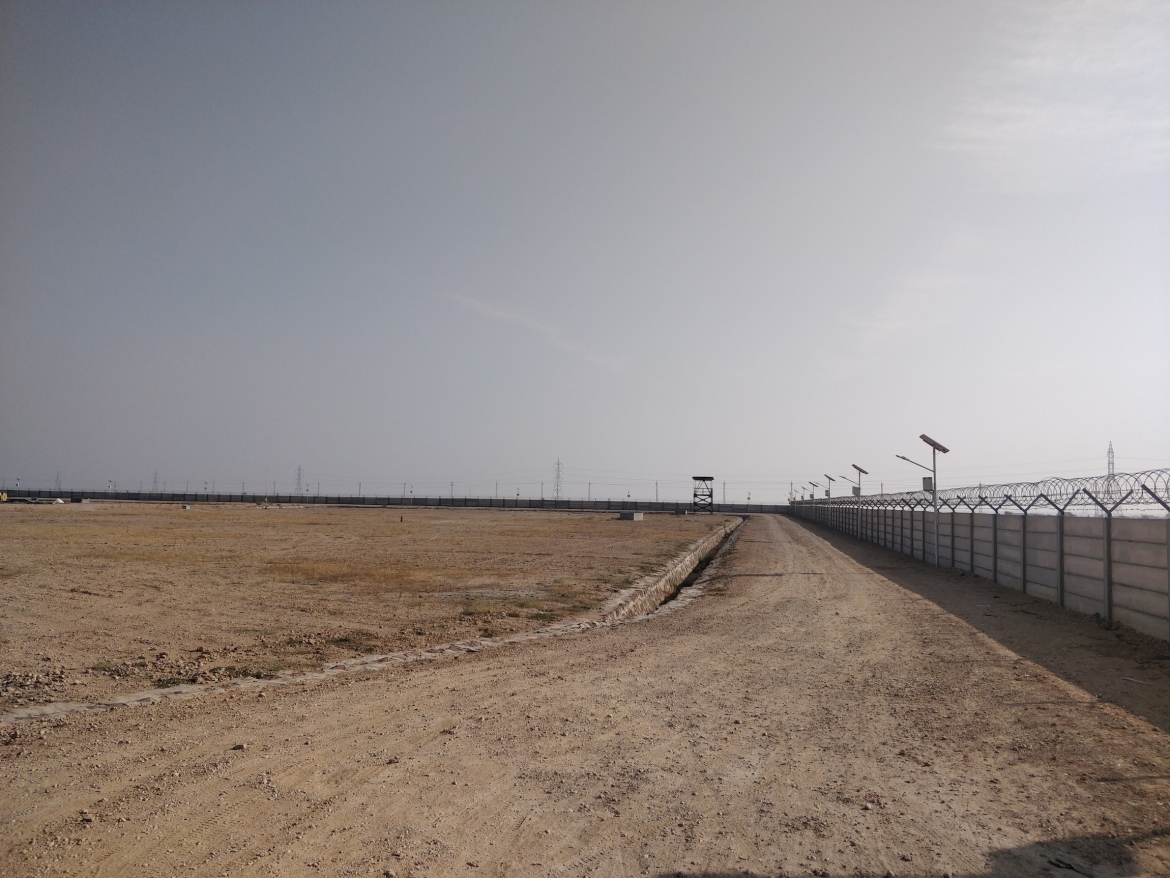 Walls with barbed wires and watch towers for security guards in place at a solar PV power plant inspected by Sinovoltaics
Walls with barbed wires and watch towers for security guards in place at a solar PV power plant inspected by Sinovoltaics
Kleptovoltaics – a worldwide phenomenon
Theft of equipment from solar PV power plants happens everywhere in the world, both in developing and also developed countries. Yet, from an operational point of view, PV power plants that are located in or near areas where dire economic conditions and/ or significant income inequality are prevalent or which experience political instability, are potentially at a higher risk. This is also true for plants in remote areas, such as for example in deserts.
In addition, as with theft in general, there are additional psychological, social and opportunistic factors that can come into play, even including peer pressure.
What can owners of PV power plants do to minimize or even eliminate the risks of theft?
While there are insurance solutions in the market that address theft, however being ex-post solutions their coverage often comes with limits that may hardly address the full scope of consequences resulting from equipment theft and also vandalism.
As a proactive approach towards this widely underreported issue, a variety of anti-theft system choices are nowadays available which we will explore in the following sections.
Systems to tackle PV equipment theft
There is a wide range of old-fashioned and innovative systems in place to deal with the theft of solar PV equipment, though their approaches vary greatly.
Some systems are rather exotic and are very rarely employed, while others are very common.
All anti-theft systems can be attributed to one or concurrently multiple macro anti-theft system categories, which are:
- Passive Anti-Theft Systems (PATS)
- Reactive Anti-Theft Systems (RATS)
- Supportive Anti-Theft Systems (SATS)
- Marking Anti-Theft Systems (MATS)
- Track & Retrieval Anti-Theft Systems (TRATS)
In fact, some systems bear inherent qualities of multiple anti-theft system categories, which we will explore further in this article.
1. Passive Anti-Theft Systems:
Passive systems are systems that by their very definition and form are not actively preventing theft but rather establish physical and audio-visual deterrents with the objective to keep thieves off. Such systems include:
- Audio Broadcasting
- Fences
- Flood Lights
- Foul Gases
- Intertwining
- Locking Fasteners
- Signages
- Walls
| Audio broadcasting | Fences | |
|---|---|---|
| Description: | Either live or pre-recorded sounds of footsteps, humans talking, laughing, whistling and dogs barking, simulating active on-site presence of human or animal guards at the installation. The sounds can be transmitted via audio devices such as (automated) loudspeakers, radios, MP3 players. Audio broadcasting can also be set up with reactive system capabilities, including the triggering of the broadcast once sensors detect intruders. | Fences basically set clear boundaries, visually and physically graspable to outsiders. Often combined with warning signages, old-fashioned perimeter fencing can be as simple and cheap as a wire mesh fence surrounding the whole installation, up to slightly more advanced structures equipped with spikes, glass sherds, stinking cloth, and other unpleasant and body-injuring additions that increase the physical costs of a theft attempt. |
| Advantages: | Audio broadcasting implies the much deterring presence of guards on-site at significantly lower setup and operational costs than employing real guards. The full potential of audio broadcasting as anti-theft system is unleashed by implementing it at multiple key points of the installation and/ or by moving the audio devices around the site. | Fences imply that an area is off-limits to any outsiders and are economic solutions that can be installed with relative ease and in a short amount of time. They work best in a body-injuring setup, most notably by electrifying the wire mesh at high voltages (subject to local regulations) that in the worst case can result in death. |
| Disadvantages: | The potential of audio broadcasting as anti-theft system can be potentially maxed out at night, while during day time thieves may easily spot that in fact there are no guards at the installation. | With no other supporting systems in place, fences alone are among the weakest anti-theft systems. Fences can be easily cut through and dug under or also climbed over. Also, electric fences may increase the overall operational costs drawing electricity either from the (storage) installation, supportive generators or the grid. |
| Flood Lights | Foul Gases | |
|---|---|---|
| Description: | Flood lights can be both static and non-static (moving search lights) and visually imply guard, search and surveillance activity on-site at the installation. They can both cover specific corners or the whole of PV installation and are a useful addition to other anti-theft systems, in particular surveillance cameras. | This type of system involves any kind of stinky, foul-smelling gases that deter thieves by there extremely abominable smells. They can both be passively employed and thus be a deterrent, but also be used as reactive system when such gases are released upon a trigger-event (such as the cutting of fences or cables) and then potentially induces thieves to vomit. Some noxious gases may even go as far as impairing eyesight. |
| Advantages: | Flood lights are an economic solution both in static and non-static configuration. Preferring to stay out of the spotlight, flood lights can during night time deter thieves from attempting to enter or even come close to the installation. | Foul gases are fairly easy and cost-efficient to deploy, either by simply piling up rubbish, rotten food such as eggs, or as sophisticated, reactive tools in form of devices that release gases following a trigger event. |
| Disadvantages: | Flood lights effectively only work during night time and are thus in terms of 24/7 security only useful in combination with other systems that work also during day time. | In a passive setup, foul gases may not only deter thieves but also authorized operators without protective equipment. Moreover, thieves equipped with gas masks/ breathers may not be deterred by any foul gases. Furthermore, humans react differently to different smells, thus as a stand-alone solution, foul gases have fairly limited anti-theft capabilities. |
| Intertwining | Locking Fasteners | |
|---|---|---|
| Description: | Intertwining usually involves connecting the PV module mounting racks, using special clamps or heavy-gauge robust cords. These cords can for example be pulled through the unused mounting holes of the modules frames, thus intertwining them, making it harder to remove the modules without cutting the cords. | Locking fasteners are special screws that are used when mounting the solar modules instead of the standard nuts and bolts. These customized bolds cannot be unlocked with standard tools but only with special keys. Upgraded versions of such locking fasteners consist of nuts with heads that break off once torque is too much, making it impossible to further grip it with any tool. |
| Advantages: | Intertwining is cost-efficient and poses an additional barrier to thieves during a theft attempt, in particular during night times. This additional barrier can cause losses in time for thieves, in the best case sufficient time losses for other systems to kick in. | Locking fasteners are a very low-cost method of securing modules against theft, necessitating the thief to come well prepared for any theft attempt, in particular when working on advanced fasteners that break off easily. |
| Disadvantages: | While in itself not very effective, however the cords can be linked to an alarm bell or other system that is triggered once the cords are cut. | During attempts to remove such modules from the installation site, thieves may inadvertently damage the mounts or even the modules when applying forceful means before eventually giving up. |
| Signages | Walls | |
|---|---|---|
| Description: | Signages are simple warning signs to warn against unauthorized trespassing and against anti-theft systems in place, such as alarms, videocameras or guards. | Like fences, walls basically set clear boundaries between protected and openly accessible area. In practice, walls are often combined with watch towers, essentially likening a solar power plant to a fortresses. |
| Advantages: | Signages are not only cheap, but can contribute to prevent thieves from going ahead by informing them that there are anti-theft systems in place, in particular since thieves may already be doing substantial damage to the installation until they become aware about these systems. Signages may also fool thieves in falsely believing in anti-theft systems used at the installation site. | As compared to fences, walls are comparably harder to overcome, especially with deep wall structures that complicate digging underneath them. Moreover, the optics of a fortress with watch towers may signal to thieves that the plant owner attaches great importance to the installation and may in fact have guards behind the walls. |
| Disadvantages: | Signages are utterly passive systems of theft prevention and may not scare many thieves, even when warning about alarms, cameras and guards on-site which professional thieves could assess by observing the installation. | Walls are usually more costly to set up as compared to fences. Moreover, as standalone anti-theft system without any additional support from guards, they can after all be overcome by patient, well-prepared thieves. |
2. Reactive Anti-Theft Systems:
Reactive systems are systems that react on the attempt of or the very execution of theft by acoustic and visual means. Reactive systems include:
- Guard animals
- Human security guards
- Motion sensor lights
- Security alarms
| Guard Animals | Human Security Guards | |
|---|---|---|
| Description: | Apart from dogs, there is quite a variety of guard animals that either due to their very territorial behavior or their excessive noise-making provide reactive protection, such as geese, donkeys, alpacas, ostriches, and even alligators. The choice of guard animal is obviously geared towards to the setup and location of the solar power plant, budget and local regulations. | Another classic is the employment of human security guards, though for budgetary considerations they are rather used for larger commercial and utility-scale installations. Depending on local regulations at the location of the solar PV plant, human security guards may also be equipped with weapons, increasing the deterrent effect. |
| Advantages: | Different guard animals have different upsides. For example: geese are very territorial, make noise and are hard to bribe, while the very nature of alligators ensures that thieves proactively keep safe distance. | A major advantage is that human security guards can be precisely trained. Moreover, their mere presence when patrolling a PV plant does often already deter thieves. |
| Disadvantages: | Dogs are more prone to bribery: a yummy (and may be even poisoned) treat may all be what is needed to disable dogs from further guarding a PV plant. On the other hand alligators cannot be trained and pose a substantial risk to life not only to the plant owners. | Human security guards can be bribed which then completely offsets their usefulness. Moreover, there is also limitations due to sleep requirements and limited attention spans. |
| Motion Sensor Lights | Security Alarms | |
|---|---|---|
| Description: | Motion light sensors are lights that get lit upon detection of movements within the detection scope of its sensor. Thus, a thief that triggers such lights coming on at night will ultimately not be able to hide and continue in the dark. Given the nature of solar PV plants – with the equipment generating high-voltage electricity during the day – and the protective layer of darkness for thieves during night time, motion light sensors are often among the primary choices of reactive anti-theft systems. | Security alarms are classic anti-theft systems employed in a variety of applications, including residential, commercial and even military areas. They are equipped with sensors and alerting devices that are triggered upon detection of intrusion of a thief. There is a great variety of sensor technologies, such as sensors based on passive infrared (PIR) motions, electro-mechanical vibrations, electrostatic fields or infrasound frequencies. |
| Advantages: | Areas that are thoroughly lit can deter thieves from further approach a PV plant as hiding spots become effectively marginalized. | Security alarms work round the clock and may provide for sufficient deterrence to thieves when detected. Depending on the sensor technology used, security alarms are also relatively inexpensive means of anti-theft protection. |
| Disadvantages: | Motion light sensors are effectively made for use at night time and thus not providing for any additional deterrence or protection during day. Thus, they are often combined with other reactive or supportive anti-theft systems. | Some security alarm systems can be susceptible to signal interruptions. Also, unless backed up by a battery, in case of power outages the security alarms won’t work. |
3. Supportive Anti-Theft Systems:
A supportive system are essentially surveillance systems designed to document and monitor thefts for subsequent identification of the perpetrators, with some more advanced systems even capable of incorporating reactive features such as alarm sounds:
- Surveillance cameras
- Unmanned aerial vehicles (UAVs)
| Surveillance Cameras | Unmanned Aerial Vehicles | |
|---|---|---|
| Description: | Surveillance cameras are increasingly becoming common sight in cities worldwide and are also used as anti-theft systems in solar PV power plants. Equipped with night vision and – thanks to technological progress also facial recognition – capabilities, not only is their deterring effect increasing, but they also have to a certain extent their usability for retrieving stolen PV equipment. | Unmanned aerial vehicles (UAVs) are still rarely used as theft protection systems, but with technological advances in terms of flight time and increasing burdensome requirements of PV plant monitoring including in remote areas, they may increasingly become a preferred choice for owners to not only perform operations and maintenance tasks, but also for patrolling the plant as flying sentries. |
| Advantages: | Surveillance cameras are comparatively cost-efficient and can be operated 24/7. Moreover, technological progress strengthens the capabilities as combined supportive-retrieval anti-theft systems as well. Combined with alarm systems that are triggered by thermal or movement sensors, surveillance cameras can be a powerful anti-theft system. | UAVs can operate like flying cameras and can therefore as well be equipped with night vision, thermal and other movement sensors as well as facial recognition capabilities. Different from surveillance cameras, a single UAV can monitor a much larger area and – to a certain extent – even leave the perimeters of a PV plant to catch more data during a theft. Also like surveillance cameras, UAVs are most powerful when linked to alarm systems. |
| Disadvantages: | Even with thermal sensors or facial recognition technology, the retrieval functions of surveillance cameras are limited by the extent thieves cover their faces and movements. Moreover, surveillance cameras in general still require human beings to review recordings ex post, meaning after theft has already happened. | Single UAVs cannot be operated for 24/7 as they require regular recharging intervals, therefore usage of multiple UAVs is required for 24/7 monitoring which with the current cost-levels can be very expensive, especially for smaller installation. Similar to surveillance cameras, human beings are still required to review recorded material. |
4. Marking Anti-Theft Systems:
Identification systems facilitate the finding and thus potential retrieval of stolen PV equipment to their place of origin and owner. Moreover, they can render the stolen equipment essentially worthless on the open market if linking to (public) blacklists. However, in general, unless the stolen equipment is cross-checked against a database, identification systems provide for poor retrieval capabilities. Identification systems include:
- Barcodes
- Forensic Marking
- RFID tags
- Serial Numbers
| Barcodes | Forensic Identification | |
|---|---|---|
| Description: | Barcodes are identifiers to present or link to data by special scanners. There is a great variety of barcodes, including types of linear barcodes (specific patterns of lines, spaces and widths thereof) and matrix (or: two-dimensional) barcodes and contain more data than linear barcodes. Matrix codes can come in different subtypes, with Quick Response (QR) codes being among the most popular types. While usually in monochrome colors, some subtypes of barcodes use colors as differentiators, such as JAB codes. | Forensic Identification (or: Forensic Marking) is the application of an adhesive on the PV equipment which is only visible under UV light. Particular identifiers such as owner or PV plant identifier can be integrated with such markings. Aside from PV equipment, also thieves can be forensically marked by spraying the adhesive on them once a trespassing event is triggered. Some forensic marking solutions in the market – such as Selecta DNA – use adhesives that contain uniquely-coded microdots that stay on the property or sprayed on a thief for weeks and whose unique code can be cross-referenced with databases. |
| Advantages: | Most PV equipment is usually delivered by the manufacturer with barcodes, thus making it one of the most cost-efficient anti-theft system. | Forensic Identification is a relatively stealth and non-erasable way to mark modules, inverters and other valuable PV equipment. Upon finding the stolen equipment, there is no doubt about ownership. Costs and procedures of implementing forensic marking as solution are also low. |
| Disadvantages: | Relying on pure barcodes as anti-theft system is almost akin to not having any anti-theft system in place but simply rely on the built-in barcodes on the PV equipment only. In addition to the inherent challenge of finding the stolen equipment, barcodes need to be scanned and can however either be erased, taped over or otherwise be concealed. Therefore, barcodes are often linked to other systems. | Similar to most MATS solutions, a big drawback is the passivity of forensic marking. It only works when actively scanning for stolen PV equipment. Moreover, police need to be educated about this anti-theft system and be equipped with the proper scanning tools. |
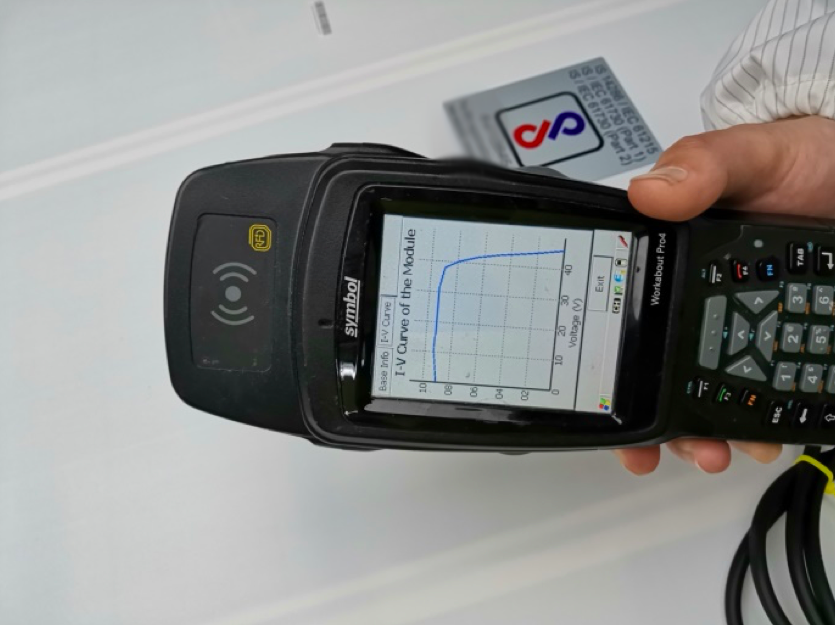
RFID reader scanning an RFID tag on a solar PV Module
| RFID Tags | Serial Numbers | |
|---|---|---|
| Description: | RFID is the acronym for radio-frequency identification which uses electromagnetic fields to automatically identify, read and track RFID tags integrated with objects such as PV equipment. They are memory devices on which multiple information is electronically stored on a built-in RFID chip in form of bits and bytes. They come in different sizes, forms and radio frequencies, such as LF (low frequency), HF (high frequency) and UHF (ultra-high frequency) tags. RFID tags consist of an integrated circuit (RFID chip or simply IC) that stores and processes the data and an antenna for communication with a reading device – the RFID reader. | Serial numbers are unique numerical, alphabetical, numero-alphabetical and/or typographical identifiers which usually are assigned to single units of any goods, including PV equipment. Most of the equipments in a PV power plant come per default with a serial number to facilitate identification, including modules, inverters and transformers. Nowadays, serial numbers are often combined with barcodes. |
| Advantages: | RFID readers can read dozens of tags simultaneously and do not require close physical contact and sight between the reader and the tag. Depending on the frequency type, distances of 100 and more meters as well as objects between the RFID reader and the tag don’t pose a barrier, allowing for tracing of stolen equipment within close perimeters and thus allow for quick tracing, provided other anti-theft systems are in place as well. | Like barcodes, PV equipment is usually delivered by the manufacturer with serial numbers (and along with barcodes), thus making it one of the most cost-efficient anti-theft system. Also, in some circumstances – depending on the serial number coding method – serial numbers may help to identify the makers and date of manufacture of a piece of equipment. |
| Disadvantages: | To protect solar PV equipment, RFID tags only work properly in close perimeters of a few hundred meters and in connection with other anti-theft systems, such as security guards. Employed as a stand-alone solution, one would need to roam around with an RFID scanner searching for the tags which is almost a futile endeavor. | Akin to barcodes, serial numbers per se are not very helpful anti-theft systems and almost fully rely on additional systems and tools – such as online database for cross-checking – to make them work to some degree. |
5. Track & Retrieval Anti-Theft Systems
Track & Retrieval Anti-Theft Systems are capable of reacting to thefts and enable the owner to geo-locate and subsequently retrieve the stolen equipment by involving the respective local authorities.
One such system is TRAPS (Theft Reconnaissance Access Protection System) which is engineered and integrated in solar PV installations by PV-specialized security technology company Viamon from Germany in partnership with Sinovoltaics Group.
Theft Reconnaissance Access Protection System: how does it work?
TRAPS is smart GPS-based geo-fencing technology that secures equipment of solar PV power plants, such as modules and inverters by equipping them with alarm and geo-tracking functionalities, enabling owners and operators to not only protect but also retrieve their PV assets in the event of theft.
The TRAPS device includes sensors and SIM cards and is embedded directly in the PV equipment, invisible from the outside. The sensors react to movements, swings, jolts and position changes, triggering immediate alarms and communicating the event of theft via various customer-defined communication channels, including SMS, e-mail, app notifications or calls.
Concurrently, the device sends out constant signal pings of the GPS coordinates of the stolen asset it is integrated with, leading police directly to the thieves’ hideout.
TRAPS works under various climatic conditions, spanning from coastal areas to snowy mountains and deserts across the globe.
How is TRAPS implemented?
TRAPS can be integrated with the PV equipment both during manufacturing and in-situ at the PV plant after installation. To maximize protection from the start and cost-efficiency, integration early on during manufacturing is recommended. Viamon and Sinovoltaics collaborate on the integration of TRAPS on-site at factories of solar module and inverter manufacturers in Asia before the equipment is shipped to projects worldwide.
To date, TRAPS has been integrated in solar farms on 5 continents, including in Germany, India, China, Namibia, Spain, Chile and Dominican Republic with a cumulative capacity of over 1,000MWp.
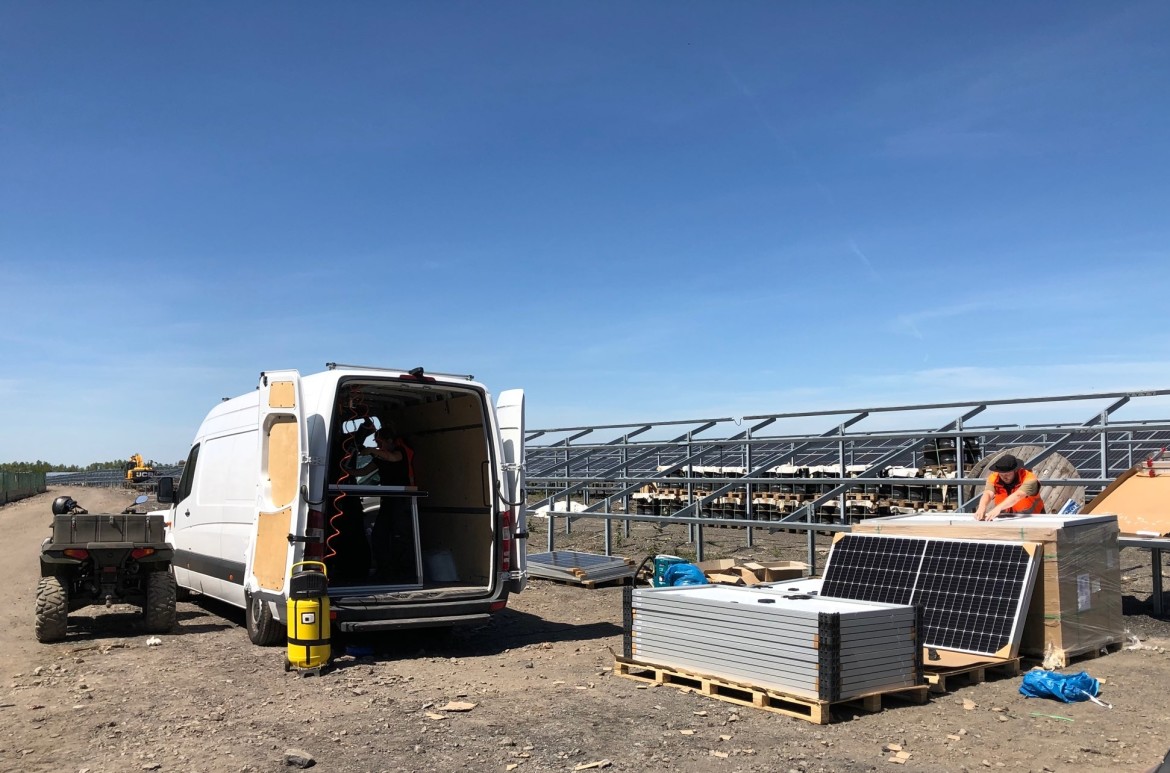 Refitting of TRAPS in-situ at a solar PV power plant
Refitting of TRAPS in-situ at a solar PV power plant
Advantages of TRAPS
Unlike any other anti-theft system, TRAPS enables asset owners to potentially retrieve the stolen PV equipment. The device has a wide range of features to protect solar PV assets, retrieve losses and provide evidence to police for further criminal investigation against thieves:
- not visible from the outside
- GPS for geo-fencing and tracking
- operable worldwide without maintenance requirements and including under extreme climatic conditions such as in deserts
- configurable sensitivity parameters based on local conditions
- instant alarm and notification on theft
- long-lasting built-in battery enabling tracking equipment for over 30 days
- warranty back-up in the event of equipment warranties being declared voided by supplier due to integration of TRAPS
- insurability: leading insurers require the implementation of TRAPS in solar PV plants
Disadvantages of TRAPS
Despite all its outstanding advantages over any other anti-theft system for solar PV assets, one disadvantage of TRAPS in applications without local power supply, such as involving cable security and passive infrared (PIR) sensors, is the requirement to replace the built-in batteries after about 10 years of operation.
However, the timely replacement of the battery before its end of life is per default part of the service agreement and the developer is also working on de-centralized power supply solutions for these applications. On the other hand, applications with local power supply such as with modules and inverters come with extended operational time of over 20 years.
Summary
As outlined in this article, there is a variety of anti-theft systems on the market or applicable to protecting PV power plants. Proper PV project risk management mandates the de-risking of technical and quality risks, involving manufacturer pre-qualification and PV equipment quality assurance.
But, beyond addressing the potential technical and quality risks in the long lifetime of a PV project, securing PV plants against the fallouts from thefts is increasingly becoming a prudent exercise for successful project developers. Choosing the right anti-theft system and technology to safeguard a PV plant can potentially make an enormous difference between commercially successful PV projects as well as commercial failures.

